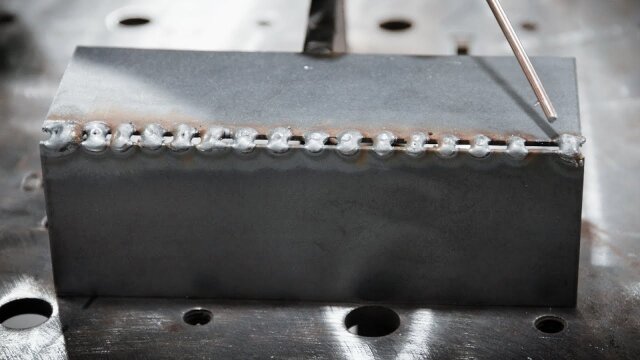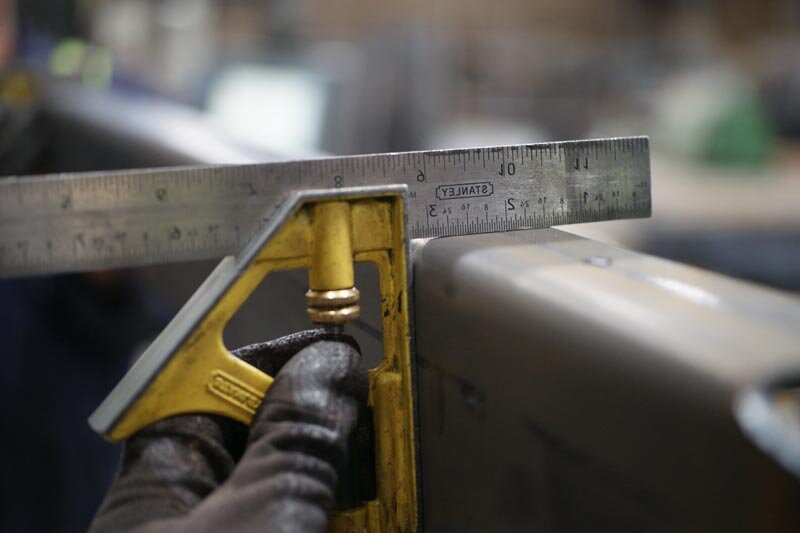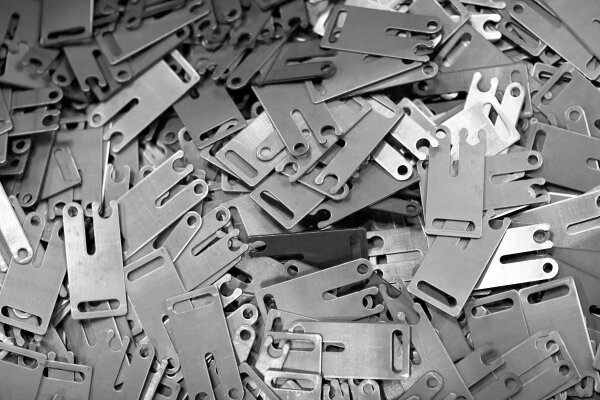يكافح العديد من المهندسين والمصممين لتحويل الأفكار إلى أجزاء دقيقة بسرعة. يحل التوجيه باستخدام الحاسب الآلي هذه المشكلة. فهو يُسرّع من عملية التصنيع الآلي ويضمن الدقة ومناسب لمختلف المواد. ويمكن من خلاله تصنيع القِطع المخصصة بسرعة وبشكل متكرر، حتى على دفعات صغيرة.
إذا كنت ترغب في معرفة كيف يمكن للتوجيه باستخدام الحاسب الآلي أن يفيد إنتاجك، فاقرأ لمزيد من التفاصيل العملية والأفكار المفيدة. يفصِّل هذا الدليل كل شيء، بدءًا من المبادئ الأساسية إلى التطبيقات العملية، مما يساعدك على فهم هذه الطريقة الفعالة في التصنيع الآلي بسرعة.
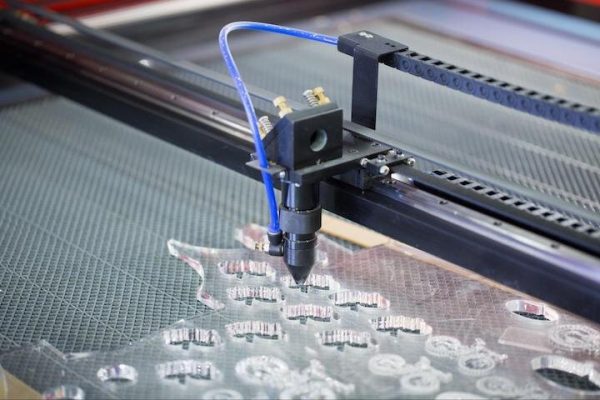
ما هو التوجيه باستخدام الحاسب الآلي الرقمي (CNC)؟
التوجيه باستخدام الحاسب الآلي عبارة عن عملية قطع تعمل بالكمبيوتر. وهي تستخدم لقمة دوارة لقطع المواد على طول مسار دقيق. تقرأ الماكينة ملف تصميم رقمي ثم تتبع مسار الأداة المبرمج لتشكيل الجزء.
تعمل هذه الطريقة بشكل أفضل مع الأجزاء المسطحة و2.5D. وتتعامل مع البلاستيك والخشب والألومنيوم والرغوة وغيرها. تُستخدم للعلامات والألواح والمرفقات والنماذج الأولية. يمكن للماكينة تكرار نفس المهمة مرارًا وتكرارًا مع اختلاف بسيط.
كيف يعمل التوجيه باستخدام الحاسب الآلي: خطوة بخطوة
يحول التوجيه باستخدام الحاسب الآلي التصاميم الرقمية إلى أجزاء مادية من خلال عملية آلية دقيقة ودقيقة. وإليك كيفية حدوث ذلك:
إعداد التصميم وبرنامج CAD
الخطوة الأولى هي إنشاء رسم رقمي باستخدام برنامج CAD. يوضح هذا الرسم شكل الجزء وحجمه وقواطعه. وبناءً على احتياجات المنتج، يضيف المصممون الثقوب والمنحنيات والحواف.
برمجة CAM وإنشاء مسار الأدوات
بمجرد أن يصبح التصميم جاهزًا، يتم استيراده إلى برنامج CAM. هنا، ينشئ البرنامج مسار أداة. ثم يقوم برنامج CAM بإنشاء كود G بناءً على تلك الإعدادات. كود G هو الملف النهائي الذي يقرأه جهاز التوجيه.
إعداد الماكينة والمعايرة
يقوم المشغل بتحميل المادة على السرير وتثبيتها في مكانها. بعد ذلك، يتم تثبيت لقمة القطع اليمنى في عمود الدوران. يجب تصفير الماكينة، مما يعني ضبط نقطة البداية للمحاور X وY وZ. يمكن للمشغل أيضًا التحقق من المحاذاة ووضوح الأداة.
التوجيه والقطع الفعلي
بمجرد ضبط كل شيء، يقوم المشغّل بتحميل ملف الكود G ويبدأ تشغيل الماكينة. يتحرك جهاز التوجيه على طول المسار المبرمج ويقطع المادة طبقة تلو الأخرى.
التشطيب وفحص الجودة
بعد القطع، تتم إزالة الجزء من الماكينة. قد يحتاج إلى بعض التشطيب - صنفرة الحواف الخشنة, إزالة النتوءاتأو تنظيف الغبار. بعد ذلك، تخضع لفحص الجودة. يتحقق المشغل من القياسات وأحجام الثقوب وجودة القطع.
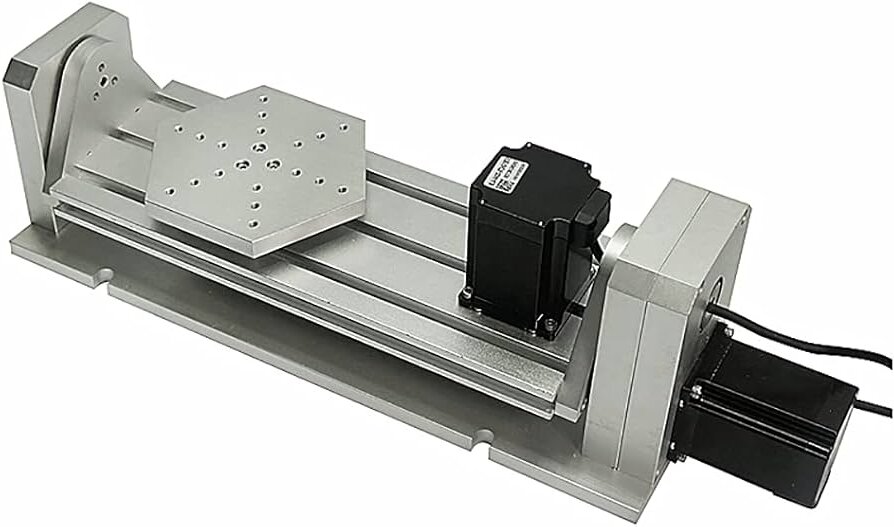
ما هي المكونات الرئيسية لجهاز التوجيه باستخدام الحاسب الآلي؟
يحتوي كل جهاز توجيه بنظام التحكم الرقمي على بعض الأجزاء الأساسية التي تعمل معًا. تحدد هذه المكونات مدى دقة الماكينة وثباتها وسرعتها.
إطار وطاولة
الإطار يثبت كل شيء في مكانه. يجب أن يكون قوياً وثابتاً. يقلل الإطار الصلب من الاهتزاز أثناء القطع. اهتزاز أقل يعني جودة أفضل للقطع.
الطاولة هي المكان الذي توضع فيه المادة. تستخدم بعض الطاولات الشفط بالتفريغ لتثبيت المواد. والبعض الآخر يستخدم المشابك. تحافظ الطاولة المسطحة والمتينة على المواد من الحركة.
نظام القنطرة
القنطرة هي الجسر المتحرك فوق الطاولة. وهي تحمل عمود الدوران على طول المحورين X وY. تمنع القنطرة القوية الانحناء أثناء الحركة.
تستخدم بعض الموجهات جسور عملاقة مفردة، بينما يستخدم البعض الآخر جسور عملاقة ذات محرك مزدوج لمزيد من الثبات. كلما كانت حركة القنطرة أكثر سلاسة، كان القطع النهائي أفضل.
المغازل والمحركات
يحمل عمود الدوران أداة القطع ويدور بها. يقوم بقطع المادة أثناء تحركها. المغازل لها تصنيفات طاقة مختلفة، تقاس بالحصان أو الكيلووات.
المزيد من الطاقة يعني قطع أسرع وتمريرات أعمق. سرعة عمود الدوران مهمة أيضًا. ارتفاع عدد الدورات في الدقيقة أفضل للتفاصيل الدقيقة والمواد اللينة. تتحكم المحركات في عمود الدوران وحركة جهاز التوجيه.
حاملات الأدوات وأدوات القطع
تقوم حوامل الأدوات بتوصيل أدوات القطع بعمود الدوران. يجب أن تثبت الأدوات بإحكام لتجنب التذبذب. تشمل الأنواع الشائعة أطواق ER أو حوامل ISO.
تأتي أدوات القطع بأشكال عديدة، بما في ذلك القطع المستقيم والقطع بزاوية, النقشوأكثر من ذلك. تعتمد الأداة المناسبة على المادة والتصميم.
وحدات تحكم CNC والواجهات البينية
وحدة التحكم هي دماغ جهاز التوجيه. فهي تقرأ الكود G وتخبر الماكينة بما يجب القيام به. كما أنها ترسل الأوامر إلى المحركات والمغازل والأنظمة الأخرى.
الواجهة هي كيفية تحكم المشغل في جهاز التوجيه. بعض الأنظمة تستخدم شاشات تعمل باللمس، والبعض الآخر يستخدم برامج على الكمبيوتر الشخصي. الواجهة البسيطة تجعل تشغيل الماكينة أسهل.
أنظمة القيادة: السائر مقابل المحركات المؤازرة
تتحرك أجهزة التوجيه بنظام التحكم الرقمي باستخدام محركات السائر أو المحركات المؤازرة. المحركات السائر أرخص، وتتحرك بخطوات ثابتة، وهي جيدة للأعمال الأساسية.
المحركات المؤازرة تكلف أكثر ولكنها تعطي حركة أكثر سلاسة وسرعة ودقة. وهي تعمل بشكل أفضل للمهام المعقدة أو الأشواط الطويلة.
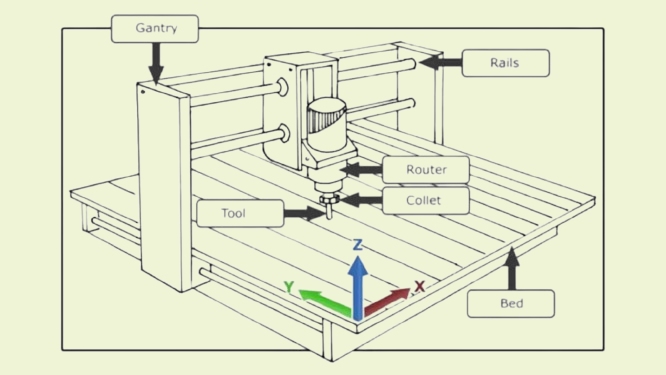
أنواع أجهزة التوجيه باستخدام الحاسب الآلي وتصنيفها
تأتي الموجهات بنظام التحكم الرقمي بتصميمات مختلفة للتعامل مع مختلف المهام. دعونا نلقي نظرة على كيفية تصنيفها.
استنادًا إلى هيكل الماكينة
أجهزة التوجيه العملاقة باستخدام الحاسب الآلي العملاقة
تحتوي الموجهات الجسرية على طاولة ثابتة وجسر متحرك. تحمل القنطرة رأس القطع وتتحرك عبر الجزء. هذا التصميم جيد لقطع العمل الكبيرة. إنه مستقر ويمكنه التعامل مع المهام عالية السرعة.
أجهزة التوجيه هذه شائعة في الصناعات التي تعمل بألواح كاملة من المواد. وهي مثالية للعلامات والألواح وقطع الأثاث.
موجهات CNC الطاولة المتحركة CNC
في هذا النوع، تظل القنطرة ثابتة بينما تتحرك الطاولة ذهابًا وإيابًا لتشكيل الجزء. يوفر هذا الإعداد دقة عالية لأن الأجزاء المتحركة أخف وزنًا.
تعد أجهزة التوجيه ذات الطاولة المتحركة أفضل للقطع الصغيرة أو الأعمال ذات التفاوت الضيق. إنها تستخدم مساحة أرضية أقل في بعض التخطيطات ولكنها قد تكون أبطأ في المهام الكبيرة.
بناءً على تكوين المحور
أجهزة التوجيه ثلاثية المحاور بنظام التحكم الرقمي باستخدام الحاسب الآلي
تتحرك هذه الموجهات في ثلاثة اتجاهات: X (من اليسار إلى اليمين)، و Y (من الأمام إلى الخلف)، و Z (من أعلى وأسفل). وهي النوع الأكثر شيوعًا.
تُعد الماكينات ثلاثية المحاور جيدة للأجزاء المسطحة والعمل 2.5D. وهي تُستخدم للقطع والنقش والحفر والحفر في الجيوب. تستخدم معظم الأعمال ذات الأغراض العامة هذا الإعداد.
أجهزة التوجيه CNC متعددة المحاور (4، 5، وأكثر)
تحتوي هذه الماكينات على حركات إضافية، مثل الدوران أو الإمالة. قد يقوم محور رابع بتدوير المادة، ويمكن للمحور الخامس إمالة أداة القطع نفسها.
يسمح ذلك بالأشكال المعقدة والقطع على جوانب متعددة دون قلب الجزء. تُستخدم الموجهات متعددة المحاور في أعمال التصميم في مجال الطيران والسيارات والتصميمات المتطورة.
استنادًا إلى تطبيق المواد
موجهات النجارة باستخدام الحاسب الآلي
صُممت أجهزة التوجيه هذه لقطع الأخشاب، وألواح MDF، والخشب الرقائقي، والمواد المماثلة. وهي تعمل بسرعة وبسرعات مغزل عالية. غالبًا ما تكون أنظمة جمع الغبار مدمجة. وهي شائعة في ورش صناعة الأثاث والخزائن واللافتات.
أجهزة التوجيه CNC المعدنية
تحتاج الموجهات المعدنية إلى طاقة أكبر وإطارات أقوى. غالبًا ما يكون لها سرعات مغزل أقل ولكن عزم دوران أعلى. وهي تعمل مع الألومنيوم، والنحاس، والمعادن غير الحديدية الأخرى. أما ماكينات التفريز بنظام التحكم الرقمي فهي أفضل للمعادن الصلبة مثل الفولاذ.
أجهزة التوجيه باستخدام الحاسب الآلي البلاستيكية والمركبة
تُستخدم هذه الموجهات لقطع الألواح البلاستيكية والأكريليك والبلاستيك PVC وألياف الكربون والألياف الزجاجية. تعتبر سرعة عمود الدوران واختيار الأداة أساسيان لتجنب ذوبان المواد أو تقطيعها. تُستخدم في التغليف، والتصاميم الداخلية للسيارات، وأغطية المنتجات.
ما المواد التي يمكن لأجهزة التوجيه بنظام التحكم الرقمي CNC قطعها؟
يمكن لأجهزة التوجيه بنظام التحكم الرقمي باستخدام الحاسب الآلي قطع العديد من أنواع مواد الألواح. وتشمل هذه الأنواع:
- الألومنيوم
- فُولاَذ
- نحاس
- نحاس
- المواد البلاستيكية مثل ABS أو الأكريليك أو البولي كربونات
- خشب و MDF
- ألواح رغوية
- المركبات
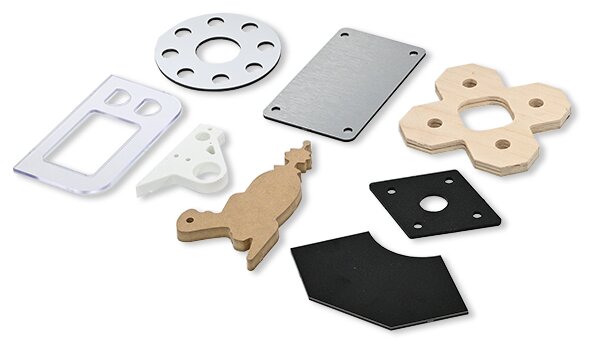
مزايا التوجيه باستخدام الحاسب الآلي بنظام التحكم الرقمي
يجلب التوجيه باستخدام الحاسب الآلي العديد من الفوائد للإنتاج الحديث. فهو يساعد على صنع قطع أفضل بشكل أسرع، بجهد أقل وتحكم أكبر.
الدقة والتكرار
تتبع أجهزة التوجيه باستخدام الحاسب الآلي التعليمات الدقيقة من ملف التصميم. كل عملية قطع دقيقة حتى أجزاء من المليمتر. بمجرد الإعداد، يمكن للماكينة تكرار نفس الجزء مرارًا وتكرارًا دون أي اختلاف.
السرعة والكفاءة
بمجرد برمجتها، تعمل الموجهات بنظام التحكم الرقمي CNC بسرعة. فهي تتحرك بسرعة بين عمليات القطع وتتعامل مع الأشكال المعقدة دفعة واحدة. قطع أسرع يعني المزيد من الإنتاج مع وقت تعطل أقل.
تقليل النفايات وتوفير التكاليف
القطع الدقيق يعني إهدار مواد أقل. الأخطاء نادرة الحدوث، وبالتالي يتم التخلص من عدد أقل من الأجزاء الملغاة. يؤدي الاستخدام الفعال للمواد والوقت إلى خفض التكاليف الإجمالية.
المرونة والتنوع في الإنتاج
تعمل أجهزة التوجيه بنظام التحكم الرقمي باستخدام الحاسب الآلي مع العديد من المواد، مثل الخشب والبلاستيك والألومنيوم. يمكن لماكينة واحدة التعامل مع العديد من المهام المختلفة. يمكنك التبديل من جزء إلى آخر عن طريق تحميل ملف جديد.
تحسين السلامة وتقليل العمالة اليدوية
يبقى المشغل على مسافة آمنة أثناء عمل جهاز التوجيه. تحافظ الواقيات والحاويات على الأجزاء المتحركة بعيدًا عن اليدين، مما يقلل من الإجهاد البدني ويساعد العمال على البقاء آمنين وفعالين.
حدود وتحديات التوجيه باستخدام الحاسب الآلي باستخدام الحاسب الآلي
بينما يوفر التوجيه باستخدام الحاسب الآلي العديد من الفوائد، إلا أنه ليس مثاليًا. عند التخطيط للإعداد، ضع في اعتبارك بعض القيود والمشكلات.
التكلفة الأولية والاستثمار
جهاز التوجيه باستخدام الحاسب الآلي عالي الجودة يكلف الكثير مقدماً. تحتاج إلى شراء الماكينة والبرامج والأدوات. وأجهزة التوجيه الأكبر أو متعددة المحاور تكلف أكثر.
التعقيد في التشغيل والتدريب
تشغيل جهاز توجيه بنظام التحكم الرقمي ليس آليًا بالكامل. يجب أن يعرف المشغلون كيفية تصميم القِطع وإنشاء مسارات الأدوات والتعامل مع إعداد الماكينة.
متطلبات الصيانة ومشكلات وقت التوقف عن العمل
مثل أي ماكينة، تحتاج أجهزة التوجيه بنظام التحكم الرقمي إلى عناية. تتآكل أدوات القطع، ويتراكم الغبار، وتحتاج المحركات والمغازل والمحركات إلى فحوصات منتظمة. إذا تعطل شيء ما، يتوقف الإنتاج.
القيود المفروضة على سماكة المواد وصلابتها
أجهزة التوجيه باستخدام الحاسب الآلي هي الأفضل للمواد اللينة إلى المتوسطة. من الصعب قطع المعادن السميكة أو السبائك الصلبة باستخدام جهاز التوجيه.
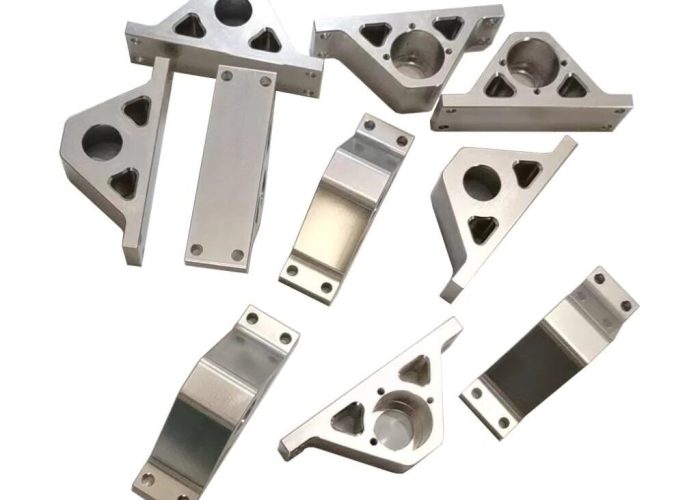
التطبيقات والقطاعات التي يخدمها التوجيه باستخدام الحاسب الآلي
يُستخدم التوجيه باستخدام الحاسب الآلي في العديد من الصناعات. فهو يساعد على إنشاء قطع دقيقة ونظيفة وجاهزة للإنتاج أو البيع.
النجارة وصناعة الأخشاب والأثاث
تقطع أجهزة التوجيه بنظام التحكم الرقمي باستخدام الحاسب الآلي الخشب الرقائقي، وخشب MDF، والخشب الصلب، وغيرها من المواد المتعلقة بالأثاث. كما أنها تصنع أبواب الخزانات، والأرفف، والألواح، والزخارف الزخرفية.
صناعة اللافتات وصناعة الإعلانات
تقوم أجهزة التوجيه بقطع الرغوة والأكريليك والبلاستيك والألومنيوم من أجل العلامات. فهي تنشئ حروفاً وشعارات وألواحاً خفيفة ذات حواف نظيفة.
تشغيل المعادن وتصنيع الصفائح المعدنية
تقوم أجهزة التوجيه بنظام التحكم الرقمي باستخدام الحاسب الآلي بقطع الألومنيوم والمعادن اللينة الأخرى من أجل المرفقات, اللوحات، و اقواس. وهي جيدة لتشكيل الصفائح المعدنية المسطحة ذات الخطوط العريضة المعقدة.
وضع النماذج الأولية وتطوير المنتجات
يستخدم المصممون أجهزة التوجيه CNC لصنع نماذج أولية سريعة. فهي تختبر الحجم والشكل والوظيفة قبل الإنتاج بكميات كبيرة.
صناعة الطيران والسيارات
تقطع أجهزة التوجيه بنظام التحكم الرقمي باستخدام الحاسب الآلي المواد خفيفة الوزن مثل المركبات وألياف الكربون والألومنيوم. تُستخدم هذه الأجزاء في الألواح الداخلية والقنوات والمبيتات.
التصنيع البحري وصناعة القوارب
يستخدم بناة القوارب أجهزة التوجيه لقطع ألواح الألياف الزجاجية والمواد الأساسية والأجزاء الداخلية. يساعد التوجيه باستخدام الحاسب الآلي في تشكيل الحواجز والمقاعد والفتحات.
التوجيه باستخدام الحاسب الآلي مقابل التفريز باستخدام الحاسب الآلي: ما الفرق بينهما؟
التوجيه باستخدام الحاسب الآلي باستخدام الحاسب الآلي الطحن باستخدام الحاسب الآلي تبدو متشابهة، ولكنها تؤدي وظائف مختلفة. تأتي الاختلافات الرئيسية من تصميم الماكينة والمواد التي تتعامل معها وكيفية قطعها.
تتحرك أجهزة التوجيه باستخدام الحاسب الآلي بشكل أسرع. فهي تستخدم مغازل عالية السرعة للمواد الأكثر ليونة مثل الخشب والبلاستيك والألومنيوم. أجهزة التوجيه رائعة لعمل الألواح، والأنماط المسطحة، والأشكال ثنائية الأبعاد.
ماكينات التفريز باستخدام الحاسب الآلي أقوى وأكثر صلابة. تتعامل مع المعادن الصلبة مثل الفولاذ والتيتانيوم. تستخدم ماكينات التفريز سرعات مغزل أقل ولكن عزم دوران أعلى. تقوم بقطع الجيوب العميقة واللوالب الدقيقة والميزات ذات التحمل الضيق.
الموجهات أخف وزنًا وعادةً ما يكون لها هيكل جسري. أما ماكينات التفريز فهي أثقل وتستخدم طاولة ثابتة مع رأس أداة متحركة. يمكن لماكينات التفريز أيضًا إجراء عمليات قطع أكثر تعقيدًا في ثلاثية الأبعاد.
| الميزة | التوجيه باستخدام الحاسب الآلي الرقمي | الطحن باستخدام الحاسب الآلي |
|---|---|---|
| الأفضل لـ | الخشب والبلاستيك والفوم والمعادن اللينة (الألومنيوم) | معادن صلبة (فولاذ، تيتانيوم)، قطع مفصلة |
| هيكل الماكينة | إطار خفيف الوزن، على شكل قنطرية خفيفة الوزن | إطار متين، صلب، صلب، على شكل عمود |
| سرعة المغزل | سرعة عالية، عزم دوران منخفض | سرعة منخفضة وعزم دوران عالٍ |
| سمك المادة | رقيقة إلى متوسطة | متوسطة إلى سميكة |
| أسلوب القطع | تمريرات سريعة وضحلة | تخفيضات بطيئة وعميقة |
| مستوى الدقة | معتدل | دقة عالية وتفاوتات أكثر دقة |
| حركة المحور | عادةً 3 محاور أو 3+1 | 3 أو 4 أو 5 محاور بمزيد من المرونة |
| نوع التطبيق | صنع اللافتات وأعمال النجارة والألواح الخشبية | الأجزاء الميكانيكية والقوالب والقوالب |
| الأدوات | قطع أصغر، حاملات بسيطة | قواطع أكبر، حاملات أدوات متطورة |
| الإعداد والتشغيل | أسهل في الإعداد وأسرع في الدورة الزمنية | يتطلب إعداداً ماهراً، ووقت دورة أبطأ |
خاتمة
يعد التوجيه باستخدام الحاسب الآلي طريقة سريعة ودقيقة ومرنة لقطع وتشكيل الخشب والبلاستيك والألومنيوم. تستخدم أدوات يتم التحكم فيها بالكمبيوتر لاتباع التصميمات الرقمية بدقة عالية. هذه العملية مثالية لصنع القِطع المخصصة والنماذج الأولية واللافتات والألواح وما إلى ذلك.
هل تبحث عن حل توجيه باستخدام الحاسب الآلي يناسب احتياجات مشروعك؟ أخبرنا عن تصميمك أو موادك أو الكمية المستهدفة - سيساعدك فريقنا في العثور على أفضل الطرق وأكثرها فعالية من حيث التكلفة. اتصل بنا اليوم للحصول على عرض أسعار سريع ودعم الخبراء.
الأسئلة الشائعة
ما هو الفرق بين جهاز التوجيه باستخدام الحاسب الآلي باستخدام الحاسب الآلي والمغزل؟
جهاز التوجيه باستخدام الحاسب الآلي هو عبارة عن ماكينة تتحرك على طول مسارات مبرمجة لقطع أو تشكيل المواد. المغزل هو جزء واحد فقط من جهاز التوجيه. إنه المحرك الذي يدور أداة القطع. بينما يحرك جهاز التوجيه الأداة، يوفر المغزل الطاقة والدوران اللازمين للقطع.
هل يمكنني استخدام أي بتات موجه لماكينات التوجيه باستخدام الحاسب الآلي؟
ليست كل لقمات الموجه مناسبة. أنت بحاجة إلى لقم مصممة للاستخدام باستخدام الحاسب الآلي. هذه اللقم مصممة للتعامل مع السرعات العالية والقطع المستمر. قد يؤدي استخدام لقمات الموجه اليدوية العادية إلى قطع رديء أو كسر الأداة.
ما هي التكلفة النموذجية لجهاز التوجيه باستخدام الحاسب الآلي؟
تختلف أسعار أجهزة التوجيه باستخدام الحاسب الآلي. تبدأ أسعار الماكينات المكتبية للمبتدئين من $2,000-$5,000. يمكن أن تكلف الماكينات متوسطة المدى للشركات الصغيرة $10,000-$30,000. قد تتجاوز تكلفة أجهزة التوجيه الصناعية ذات الأسرة الكبيرة والميزات متعددة المحاور $50,000.
كم من الوقت يستغرق تعلم التوجيه باستخدام الحاسب الآلي؟
يمكن لمعظم الناس تعلم الأساسيات في غضون أسابيع قليلة. تتيح لك الممارسة اليومية أن تشعر بالراحة في تصميم التصميم بمساعدة الحاسوب وبرمجة CAD وإعداد الماكينات في غضون شهر إلى شهرين. أما الإتقان الكامل فيستغرق وقتًا أطول، خاصةً بالنسبة للمشاريع المعقدة.
مهلا، أنا كيفن لي

على مدى السنوات العشر الماضية، كنت منغمسًا في أشكال مختلفة من تصنيع الصفائح المعدنية، وشاركت رؤى رائعة هنا من تجاربي عبر ورش العمل المتنوعة.
ابقى على تواصل

كيفن لي
لدي أكثر من عشر سنوات من الخبرة المهنية في تصنيع الصفائح المعدنية، وتخصصت في القطع بالليزر، والثني، واللحام، وتقنيات معالجة الأسطح. كمدير فني في شنغن، أنا ملتزم بحل تحديات التصنيع المعقدة ودفع الابتكار والجودة في كل مشروع.

